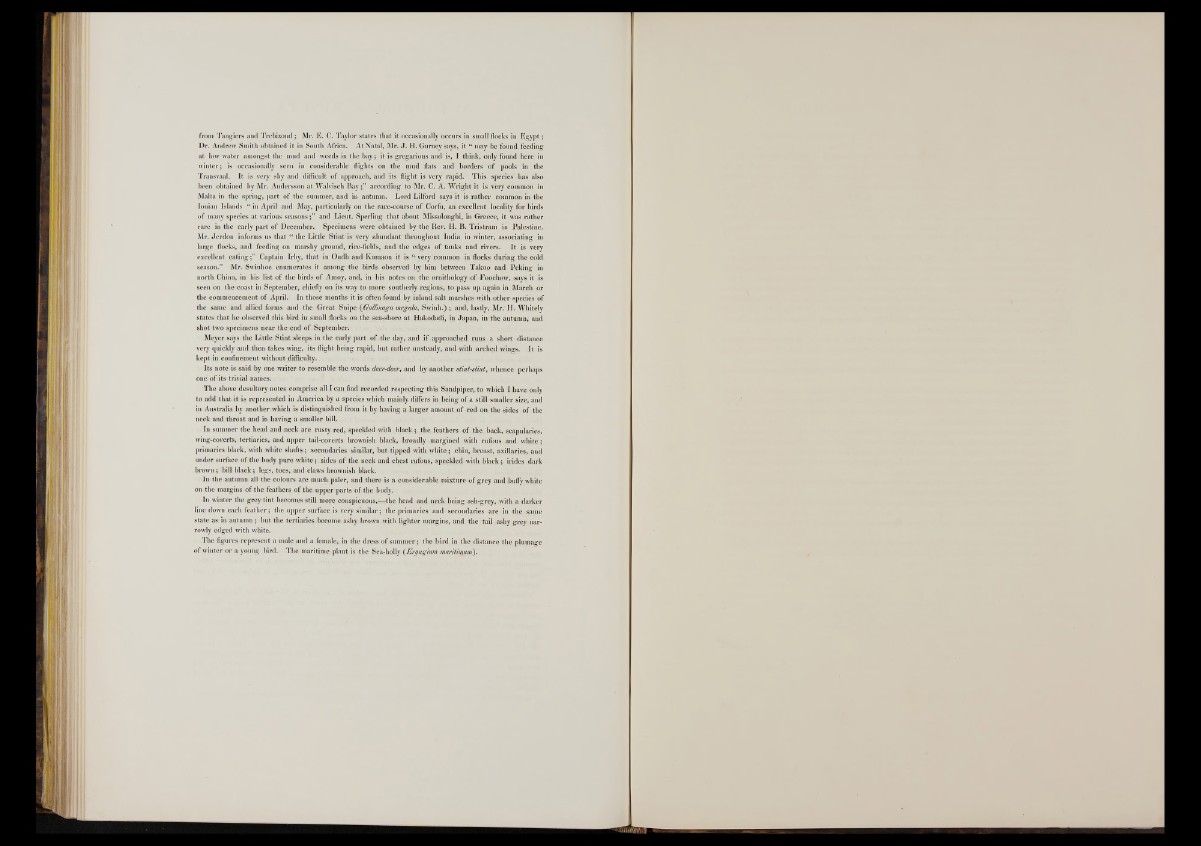
from Tangicrs and Trebizond ; Mr. E. C. Taylor states that it occasionally occurs in small flocks in E g y p t;
Dr. Andrew Smith obtained it in South Africa. At Natal, Mr. J . H. Gurney says, it “ may he found feeding
at low water amongst the mud and weeds in the bay; it is gregarious and is, I think, only found here in
winter; is occasionally seen in considerable flights on the mud flats and borders o f pools in the
Transvaal. It is very shy and difficult of approach, and its flight is very rapid. This species has also
been obtained by Mr. Andersson a t Walvisch B a y a c c o r d in g to Mr. C. A. Wright it is very common in
Malta in the .spring, part o f the summer, and in autumn. Lord Lilford says it is rather common in the
Ionian Islands “ in April and May, particularly on the race-course o f Corfu, an excellent locality for birds
of many species a t various s e a s o n s a n d Lieut. Sperling that about Missolonghi, in Greece, it was rather
rare in the early part o f December. Specimens were obtained by the Rev. H. B. Tristram in Palestine.
Mr. Jerdon informs us that “ the Little Stint is very abundant throughout India in winter, associating in
large flocks, and feeding on marshy ground, rice-fields, and the edges of tanks and rivers. I t is very
excellent eating;” Captain Irby, that in Oudh and Kumaon it is “ very common in flocks during the cold
season.” Mr. Swinhoe enumerates it among the birds observed by him between Takoo and Peking in
north China, in his list of the birds o f Amoy, and, in his notes on the ornithology o f Foochpw, says it is
seen on the coast in September, chiefly on its way tp more southerly regions, to pass up again in March or
the commencement o f April. In those months it is often found by inland salt marshes with other species of
the same and allied forms and the Great Snipe (Gallinago tnegala, Sw in h .); and, lastly, Mr. H. Whitely
states that lie observed this bird in small flocks on the sea-shore a t Hakodadi, in Japan, in the autumn, and
shot two specimens near the end o f September.
Meyer says the Little Stint sleeps in the early part o f the day, and if approached runs a short distance
very quickly and then takes wing, its flight being rapid, but rather unsteady, and with arched wings. It is
kept in confinement without difficulty.
Its note is said by one writer to resemble the words deer-deer, and by another stint-sthit, whence perhaps
one of its trivial names.
The above desultory notes comprise all I can find recorded respecting tins Sandpiper, to which I have only
to add that it is represented in America by a species which mainly differs in being of a still smaller size, and
in Australia by another which is distinguished from it by having a larger amount o f red on the sides o f the
neck and throat and in having a smaller bill.
In summer the head and neck are rusty red, speckled with black ; the feathers o f the, back, scapularies,
wing-coverts, tertiaries, and upper tail-coverts brownish black, broadly margined with rufous and wh ite;
primaries black, with white shafts; secondaries similar, but tipped with white; chin, breast, axillaries, and
under surface of the body pure white; sides of the neck and chest rufous, speckled with black; irides dark
brown; bill black; legs, toes, and claws brownish black.
In the autumn all the colours are much paler, and there is a considerable mixture o f grey and huffy whjte
on the margins of the feathers o f the upper parts of the body.
In winter the grey tint becomes still more conspicuous,-—the head and neck being ash-grey, with a darker
line down each feather; the upper surface is very similar; the primaries and secondaries are in the same
state as iu autumn ; but the tertiaries become ashy brown with lighter margins, and the tail ashy grey narrowly
edged with white.
The figures represent a male and a female, in the dress of summer; the bird in the distance the plumage
of winter or a young bird. The maritime plant is the Sea-holly (Eryngium maritinpini).